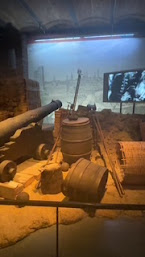Gaudi's Influence
I’ve seen a lot of beautiful architecture in Barcelona on the tours we took, but nothing compares to what I experienced walking through Park Guell and La Sagrada Familia. At first, I was just struck by how weird and fake everything felt. The architecture didn't look like something that could have been made out of rocks and tools. But the more I learned about Gaudí’s work, the more I realized it wasn’t just his creativity that drove his ideas, it was kinda political. Even though he wasn’t a politician, Gaudí’s designs reflect deep ideological beliefs, and they tie in perfectly with what we’ve been learning in POL 150 about conservatism and liberalism.
At the Sagrada Familia, everything feels overwhelming. The massive columns, the religious carvings, and the light streaming through colored glass. The Sagrada Família feels like a symbol of tradition and structure. Gaudí clearly believed that faith and order were central to society, and he built a space where everything points toward religion. That reminded me of conservative ideology, emphasizing God's role over government, shared values, and the importance of the past. Even though the church is open to everyone, it still feels like a controlled space, one that reflects a strong faith ideology.
Then there’s Park Guell, which felt completely different. It felt more aligned with liberalism. If the Sagrada Família is about order and tradition, Park Guell is about individual freedom, creativity, and personal choice. It felt less obligatory as we didn't feel the need to dress a certain way, and people could just roam around anywhere. The tour guide explained it was originally designed as a private community for the upper class, almost like a gated suburb, but the plan failed, and it eventually became a public park. That shift makes the space even more interesting. Even though it was built with elite intentions, it now functions as an open space for everyone. This place meant for a few, but it is for everyone is a very liberal belief. It made me think about how cities can be designed to either control or give freedoms, even if they’re made by an architect instead of a politician. Even though both designs have a Guadi "touch," they were made during very different portions of his life, and I feel like they reflect that. One tour guide commented that he went a little crazy towards the end of his life working on the Sagrada Familia. I wonder if his designs during parts of his life represent this.
What Gaudí’s Barcelona reflects is Catalonia itself, as he, in my opinion, literally built the city, a place fighting between unity and autonomy.




Comments
Post a Comment